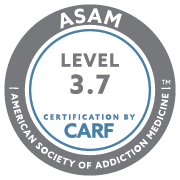It’s not uncommon for women to use the terms “drug addiction” and “drug dependence” interchangeably. However, there’s actually a fine line that separates these two conditions. When talking about addiction vs. dependence, it’s essential to know the differences in order to get yourself or someone you love the appropriate treatment. Let’s take a closer look at drug addiction and dependence and explore how to distinguish one from the other.
Understanding Addiction
In the world of substance abuse, defining addiction has very clear guidelines. These guidelines are important to establish because it helps friends and family members identify addiction in loved ones. In short, women with drug addiction are consistently using drugs in excess. Typically, this addictive behavior eventually leads them down a path of destruction.
Psychologists generally define addiction as an activity that people initially enjoy but that eventually becomes a way of life. After engaging in this activity or abusing a substance often, they need more to get the same “high” that they got from doing it the first time. As the addiction worsens, they start to make poor choices that affect their life responsibilities.
Also, it’s important to note that many factors can affect the development of addiction in women. For example, studies show that addiction can form via a combination of poor social skills and genetics. For this reason, the children of individuals with addiction are more prone to developing addiction themselves.
Understanding Dependence
Rehab centers typically use the term “dependence” to describe someone’s psychological and physical loss of control as a result of substance abuse. It can get confusing because they use “addiction” to refer to the physical aspects of drug abuse too. However, a woman who has a physical dependence on a drug is generally classified as dependent. That said, having a drug dependence doesn’t necessarily mean that she has an addiction.
Because of these similarities, it can be hard to tell the difference between addiction and dependence. For example, let’s say that a woman takes prescription pain medication. If she uses the drug for a long time, she may have to start taking more in order for that drug to work. Some doctors would diagnose this as an increased tolerance to the drug. Others, however, might diagnose it as the start of an addiction. When she needs the drug for her body to function normally, though, she has a dependence.
Addiction vs. Dependence
Now that we’ve established a better understanding of what addiction and dependence mean, let’s talk about the differences between the two. Keep in mind that drug rehab centers have their own definitions.
Traditional diagnoses label addiction as a woman’s physical reliance on a substance. Dependence describes her psychological reliance on the substance. While this makes the two terms easy to understand, experts use different terminology to describe them.
Medical experts usually refer to alcohol or drug abuse as dependence. On the other hand, they use “addiction” to describe drug use that has become the main activity. At this point, the drug addiction is a top priority in the user’s life.
Even the World Health Organization describes dependence as a collection of characteristics that begin to take priority over constructive behaviors. For example, a woman could start taking pills as an extra activity. Maybe she does it to have fun or at parties. Eventually, she takes the pills every day as the main activity. This point is when substance abuse becomes a full-blown addiction.
Does Having a High Tolerance for Drugs Lead to Dependence?
According to the National Institute on Drug Abuse, a high tolerance for a drug occurs when the user needs more of that drug to achieve the desired effects. Drug tolerance can occur in many forms. Women who drink a lot eventually need more alcohol to get drunk. Tolerance can even occur with over-the-counter medications, such as ibuprofen, when women take them on a regular basis. As a result, drug dependency can certainly occur as a woman’s tolerance level increases.
What Factors Determine the Difference Between Addiction and Dependence?
Since it’s possible to become dependent on a drug without forming a full-blown addiction, medical experts use several factors to determine if a woman has a dependency or an addiction. It’s possible for some women to take drugs heavily for several days. While their brains might adapt to the presence of the drugs, they can stop and deal with the withdrawal symptoms.
 Women who can’t stop abusing drugs have addiction. Some factors that determine whether they have addiction or dependence include:
Women who can’t stop abusing drugs have addiction. Some factors that determine whether they have addiction or dependence include:
- The length of time they’ve been using drugs
- The method in which they took the drugs
- The types of drugs they abused
- The number of times they’ve failed to stop taking the drugs
Drug Withdrawal Timeline
When dealing with drug addiction and dependence, most women want to learn more about the drug withdrawal timeline. This refers to how long they’ll deal with the symptoms of quitting substance abuse.
Unfortunately, there’s no set timeline that works for everyone. Women detox from drugs at different rates and experience different withdrawal symptoms. Regardless if they struggle with addiction or dependence, it’s crucial to seek professional help for detox. They’re much more likely to relapse if they don’t.
While there’s no set timeline, there’s a general timeline that applies to a majority of women. Keep in mind that this timeline will differ depending on the drugs that they abused, how long they abused the drugs, and if they have other underlying disorders.
Standard Withdrawal Timeline
In most cases, withdrawal symptoms start a few hours after the last dose. Despite that, it can take a few days for the symptoms to start for certain substances, such as benzodiazepines. These initial symptoms are usually pretty mild, and most women say that they’re uncomfortable but tolerable.
It typically takes 24 to 72 hours for withdrawal symptoms to peak. Cocaine withdrawal typically takes days to peak, whereas heroin withdrawal can peak within 24 hours. Once again, it could take benzodiazepine withdrawal weeks to peak.
After the peak of withdrawal, the process isn’t over just yet. While it’s true that the symptoms start to ease, women often continue to have withdrawal symptoms for days to weeks. Some drug withdrawal symptoms can last for months. In the case of benzodiazepines, the symptoms can last for a year or longer.
How to Overcome Addiction and Dependence
 Overcoming drug addiction isn’t something that women should do on their own. They have a much higher chance of success when they seek professional help at a rehab clinic. Keep in mind that not all clinics are equal. You should keep a few things in mind when you choose a clinic that fits your needs.
Overcoming drug addiction isn’t something that women should do on their own. They have a much higher chance of success when they seek professional help at a rehab clinic. Keep in mind that not all clinics are equal. You should keep a few things in mind when you choose a clinic that fits your needs.
Gender-Specific Treatment
Firstly, seek treatment that’s specific to your gender. Men and women have different needs when it comes to addiction rehab. Gender-specific centers keep these varied needs in mind. Also, it’s generally easier for women to stay focused in gender-specific facilities.
Detox
A good rehab center does more than just offer rehab; it also provides detox services. Detoxing is a vital first step when it comes to overcoming drug addiction or dependence. Thankfully, a number of centers offer both detox and rehab treatments within the same facilities.
Step-Down Approach
No one wants to jump right into rehab by hitting the ground running. Some rehab centers give women too much freedom too quickly. When this happens, relapse is a much bigger problem.
Instead, look for rehab centers that offer a step-down approach. It involves providing a large amount of support in the beginning. Then, the centers gradually allow you to manage the addiction or dependence on your own as you progress through the system.
In general, rehab centers that offer a step-down approach have different types of programs. For example, women might move into residential rehab after detox. Once they gain control of their triggers, they might move into a program that’s less restrictive, such as intensive outpatient rehab.
Alumnae Program
Rehab centers that offer alumnae programs typically rank among the best. That’s because it’s inspiring to hear from other women who have been through and overcome addiction. Alumnae programs allow those who have already completed the course to revisit the center to talk to women who are just starting their journeys.
These programs are beneficial for not only newly sober women but also the women who have already completed rehab. The alumnae programs give them a bigger purpose and can keep them motivated to stay sober.
Reach Out to New Directions for Women for Help
 Understanding the difference between addiction and dependence is important. Both are extremely dangerous and require professional help. At New Directions for Women, we pride ourselves in helping women down the road to recovery. We offer a wide range of programs to assist the recovery process, including:
Understanding the difference between addiction and dependence is important. Both are extremely dangerous and require professional help. At New Directions for Women, we pride ourselves in helping women down the road to recovery. We offer a wide range of programs to assist the recovery process, including:
- Aftercare
- Intensive outpatient programs
- Drug detox
- Residential rehab
- Alumnae programs
We help women overcome addiction and dependence on a number of drugs. This includes cocaine, heroin, and pain pills, just to name a few. Contact us to learn more about the programs that we offer and how we can help you down the path to recovery.









